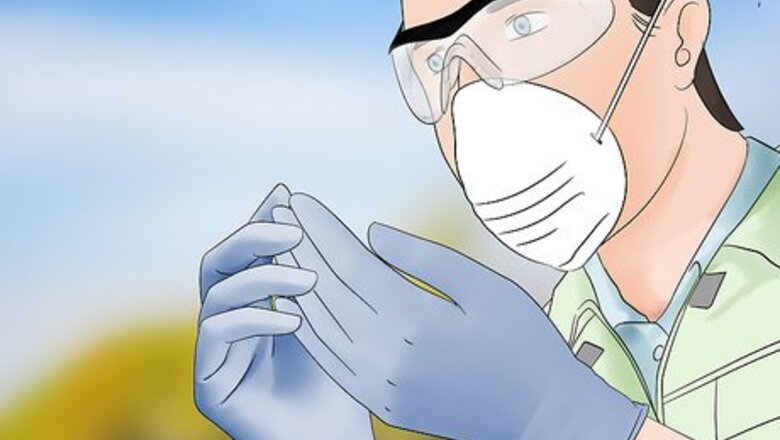
views
Maintaining Normal Chlorine Levels
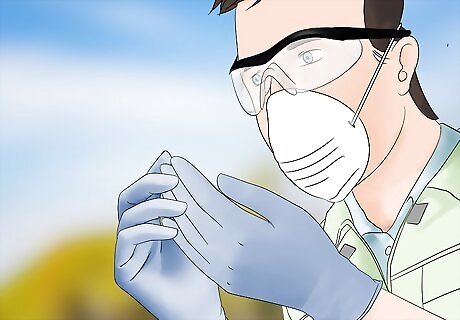
Wear protective gear and use caution when handling pool chemicals. Put on a pair of protective goggles and thick gloves before working with chlorine and other pool chemicals. If you’re treating an indoor pool, make sure there’s adequate ventilation before opening a chemical container.Safety Tip: Be especially cautious if you're using a liquid or granular product. Wear long sleeves and pants, and be careful not to spill the chlorine.
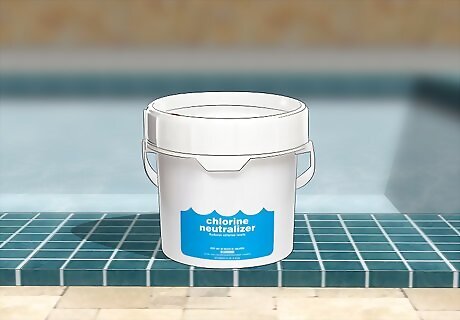
Go with chlorine tablets for the longest lasting option. Tablets are the most popular way to chlorinate a pool. They’re easier to use, last longer, and are gentler on pool liners than liquid options, which are best used as shock treatments. Unlike granulated options, tablets dissolve slowly, which ensures even distribution. Purchase chlorine tablets online or at a pool supply store. Tablets come in 1 inch (2.5 cm) and 3 inches (7.6 cm) sizes. The larger tablets are the preferred option. They’re easier to handle, last longer, and are generally less expensive than 1 inch (2.5 cm) tablets.
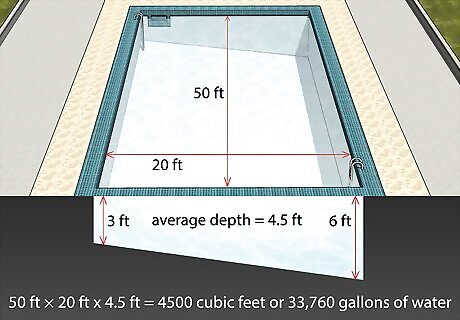
Calculate your pool’s volume if you don’t already know it. You’ll need to know how much water your pool holds in order to determine the right amount of chlorine to add. For a quick estimate, measure your pool’s length and width, find the average depth, then multiply length by width by the average depth. If your pool is circular, measure the diameter, divide that value by 2 to find the radius, then use the formula πrh, where r is the radius and h is the average depth. Suppose you have a 50 ft × 20 ft (15.2 m × 6.1 m) pool. If the shallow end is 3 ft (0.91 m) deep and the deep end is 6 ft (1.8 m) deep, the average depth is 4.5 ft (1.4 m). After finding the average depth, you'd multiply 50 × 20 × 4.5 ft (15.2 × 6.1 × 1.4 m) to find a volume of 4500 cubic feet (127 m). Since 1 cubic foot (0.028 m) contains 7.48 gallons (28.3 L) of water, your pool holds 33,760 gallons (127,800 L) of water. You can also download an app or use an online calculator to find your pool’s volume.
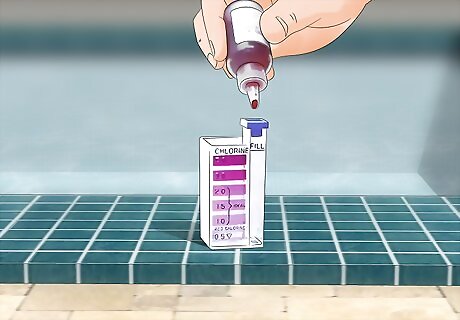
Test your pool water to determine how much chlorine to add. Before chlorinating your pool, test the pH and chemical levels using a pool water test kit. Read your product’s instructions; the label will let you know how much to add based on your pool’s volume to reach the target chlorine level in ppm. Your test kit will show multiple chlorine readings. Free available chlorine is active and kills germs, while combined chlorine is the amount that’s been used up killing germs. Test your pool water daily if it gets regular use, and maintain a free available chlorine level between 1 and 3 ppm. If you’re maintaining a spa or hot tub, keep the free available chlorine level around 4 ppm. Always round up to the nearest 5,000 gallons (19,000 L). For instance, suppose you have a 33,760 gallons (127,800 L) pool, your current chlorine level is around 0 ppm, and your product directs you to add 1 tablet per 5,000 gallons (19,000 L) to increase chlorine levels by 1 ppm. You’d need 14 tablets to achieve a reading of 2 ppm.
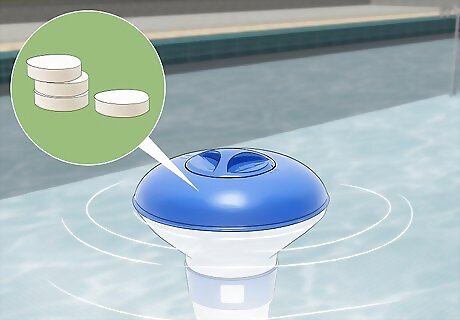
Invest in a chlorine dispenser for the most effective option. Simply tossing tablets into the pool won’t do the trick. Instead, it’s best to use a floating chlorine feeder, chlorinating skimmer, or other automatic dispensing device. All you need to do is place the tablets in the feeder’s cartridge and allow them to dissolve, which usually takes a few days. Unless your pool’s chlorine level is below 1 ppm or above 5 ppm, it’s fine to go swimming while the tablets dissolve. They’re designed for routine, continuous use. You can find chlorine dispensers online and at pool supply stores. Simple floaters are inexpensive, while skimmers that clean debris and dispense chemicals can cost hundreds of dollars (U.S.).
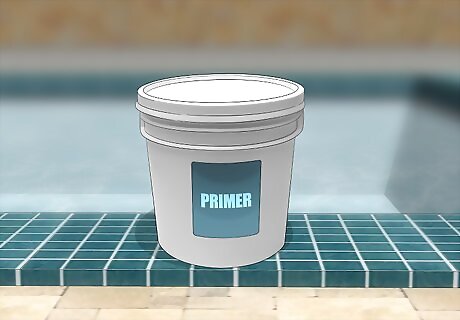
Add cyuranic acid if your chlorine product isn’t stabilized. Cyuranic acid is a stabilizer that makes chlorine last longer. If your chlorine is labeled “stabilized,” “trichlor,” or “dichlor,” it already contains cyuranic acid, and there’s no need to take any further action. If not, purchase liquid or granulated cyuranic acid, dilute it according to the package’s instructions, then add it to the pool. The right amount to add varies by product. In general, you’ll need to add about 4 pounds (1.8 kg) of cyuranic acid per 10,000 gallons (38,000 L) of water to reach a level of 10 ppm. It’s recommended to maintain a cyuranic acid level around 50 ppm. Remember to wear goggles and gloves when you mix and apply pool chemicals. Do not add cyuranic acid to a spa or hot tub.
Shocking Your Pool
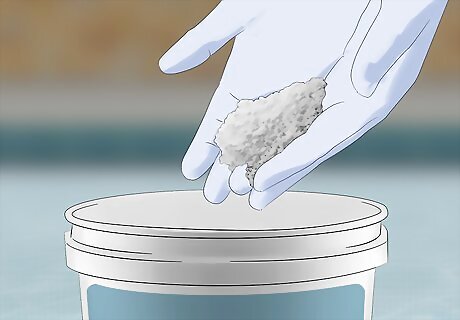
Purchase a liquid or granular chlorine shock product. While tablets are best for routine chlorination, shock treatments typically come in liquid or granular forms. Required amounts and application methods vary, so consult an employee at the pool supply store and read your product’s instructions carefully. In general, you’ll need 3.5 US quarts (3.3 L) of liquid shock treatment or 1 pound (0.45 kg) of a granular product per 10,000 gallons (38,000 L) of water. To be sure, check the instructions for the amount needed to produce a 1 ppm change in chlorine levels. Your aim is to bring free available chlorine to at least 8 ppm.
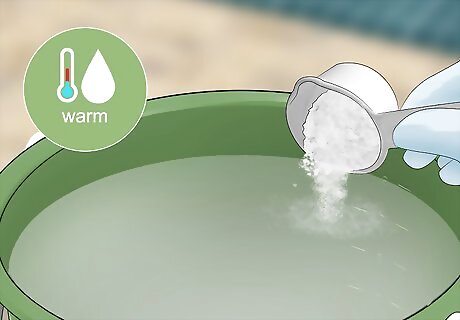
Mix the product with warm water if it needs to be dissolved. If necessary, fill a large, clean bucket with the amount of warm water called for in the instructions. Then add the recommended amount of chemical carefully to avoid spilling or dispersing fumes. Slowly mix the solution until a liquid product is evenly dispersed or a granular product is fully dissolved. Be sure to wear protective gear when diluting or applying chlorine shock treatments and any other pool chemicals.
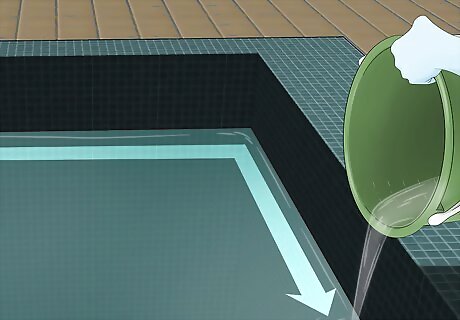
Add enough chlorine to bring the level to 8 ppm. Remember to test your pool water before adding any chemicals to it. Once you’ve measured and, if necessary, diluted the right amount of chemical, add it gradually to the pool. Pour it slowly as you walk around the pool’s perimeter to ensure even distribution. Do not add an undiluted shock treatment directly to the water unless the product’s instructions specifically call for it.Tip: You’ll get more bang for your buck if you add the shock treatment at night. Ultraviolet rays break down chlorine, so the shock treatment will be less effective if you add it during the day.
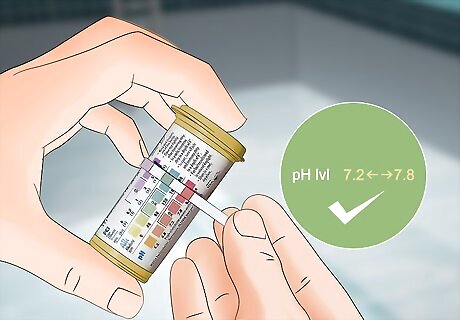
Adjust the pool water’s pH, if necessary. Some chlorine shock treatments have a pH of 10 or more, which will throw off your pool’s pH levels. If necessary, your product’s instructions will direct you to add an acidic pool water amendment to counteract the shock treatment’s high pH. Ask an employee at the pool supply store or consult your pool’s installer about the right combination of shock treatments and pH amendments. Use products as directed, and apply them in the order advised in the instructions. It’s essential to keep the pH between 7.2 and 7.8. Ideally, try to keep it right around 7.5. If it’s too high, chlorine sanitizes less effectively. If the pH is too low, chlorine can corrode pipes, damage pool lining, and irritate skin.
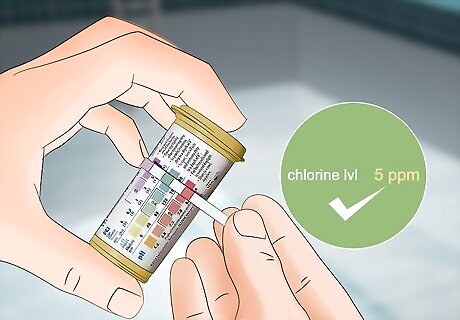
Wait until chlorine levels decrease to 5 ppm before swimming. Shock treatments bring free available chlorine levels to 8 to 10 ppm, which is outside of the safe range for swimming. Some shock treatments work quickly, and swimming is safe after just 15 to 20 minutes. For other products, you’ll need to wait 4 to 24 hours. Always test your chlorine levels after amending the pool water before you allow anyone to go swimming. Read your product’s instructions for specific wait times. Bear in mind a free available chlorine level over 10 ppm may burn the test strip and yield a false reading of 0 ppm. If that happens, retest the water after a few hours.
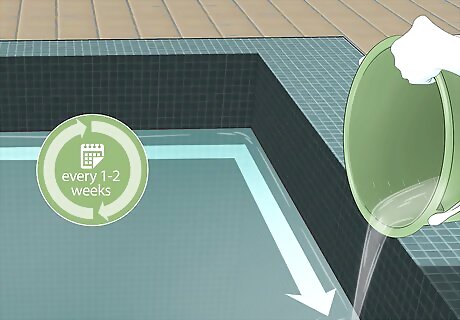
Shock your pool every 1 to 2 weeks. At a minimum, shock your pool every 2 weeks while it's in use, regardless of how often you use it. If your pool gets a lot of use, shock it weekly. Additionally, shock it after pool parties and if it’s been contaminated, such as after a bathroom-related accident. The combined chlorine level, or the amount of used up chlorine, should remain under 0.2 ppm. If it exceeds 0.2 ppm, it’s time to shock your pool. To maintain the pool in good shape, get a vacuum once a week. The plaster and pebbles cannot tolerate loads of dust on them. It does wonders to the color of the pool. It is a solution under $200 because most vacuums cost less than that.















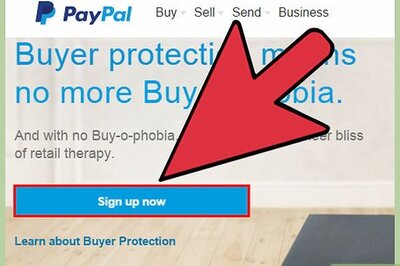



Comments
0 comment